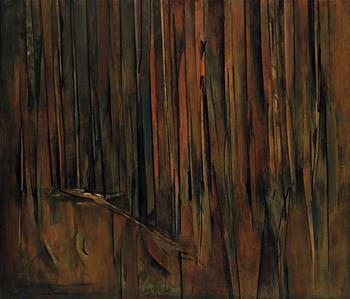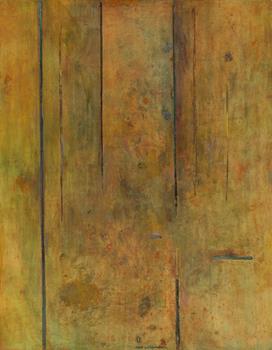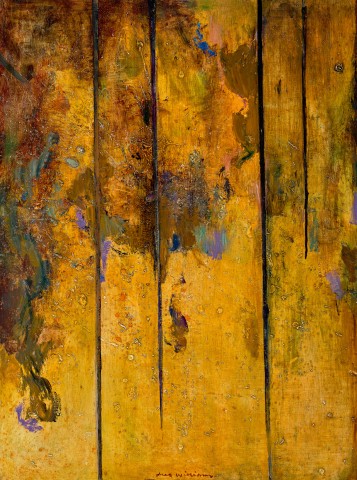SAPLING FOREST, c.1960 – 62
FRED WILLIAMS
oil on composition board
121.0 x 89.0 cm
signed lower centre: Fred Williams
bears inscription verso: 3 [LW003]
Joseph Brown Gallery, Melbourne
The Cbus Collection of Australian Art, Melbourne, acquired from the above on 4 September 1998
Art in a Time of Change, Hazelhurst Regional Gallery, Sydney, 21 January – 9 April 2000
A Century of Australian Art, Gosford Regional Gallery, New South Wales, 14 April – 28 July 2000
Fred Williams and John Nixon - Reducing Landscapes, Latrobe Regional Gallery, Victoria, 21 March – 28 June 2015 and touring
3 Perspectives | Mary Tonkin, Fred Williams & Miles Evergood, Burrinja Gallery, Dandenong Ranges Cultural Centre, Melbourne, 15 May – 24 July 2021
on long term loan to Wollongong City Gallery, New South Wales
Nainby, B., Stanhope, Z., and Furlonger, K., The Cbus Collection of Australian Art, in association with Latrobe Regional Gallery, Melbourne, 2009, p. 236
We are grateful to Lyn Williams for her assistance with this catalogue entry.
FRED WILLIAMS 1.jpg

To claim a painting, or closely connected series of paintings, as career defining can be something of a risky call. However, in Sapling Forest, 1962 and other similar paintings by Fred Williams from the same time, they reach a resolute clarity where former influences and reference points disappear and a distinctly personal and emblematic pictorial arrangement takes hold. Williams’s paintings from the 60s are the most original Australian landscape paintings by any artist of his generation.
After six years in London, which included study at the Chelsea School of Art, Williams returned to Australia in late 1957. Nationalist myth painting carried on and the rise of abstract expressionism had taken hold, especially in Sydney. Later he must have been thankful for not having been invited to join the Antipodeans and to exhibit with them in their one and only exhibition in 1959; he seemingly dodged a doctrinaire and typecasting bullet. What fresh prospects landscape painting might offer was low with expectation. Despite Williams’ unfashionable keenness for landscape, he never hoped to become an art historical repeat of former greatness. Narrative heroism or the landscape as symbolic motif never played a role.
Paintings which immediately precede Sapling Forest similarly use a strong vertical compositional format with top to bottom lines dividing the picture plane. His palette is usually softer and darker using carefully modulated half-tones in resonant glazes, as exemplified by Echuca Landscape, 1961 (Queensland Art Gallery | Gallery of Modern Art). He had travelled and painted around Echuca a couple of years earlier with Arthur Boyd – paintings and ideas were further developed in the studio. It was a foundation from which the vibrant expression in Sapling Forest followed. It was also the year Williams won the Wynne Prize with Sherbrooke Forest, 1961 (Art Gallery of New South Wales) – an ensemble of vertical lines across glazes of subdued shadowy light.
FRED WILLIAMS.jpg

References to Cezanne and Cubism in works such as The Charcoal Burner, 1959 no longer appeared as an underlying compositional solution, and suggestions of closely observed topographical elements are made minimal or eliminated. But Matisse remained a constant and discreet presence – forms delineated in black and tonal passages broken with coloured accents appear in various iterations.
Williams’ use of glazes is an important and repeating trait – his appreciation of them gleaned through looking at the work from old masters to Corot. It is a deep historical understanding used to contemporary effect; the quickly painted gestures are a characteristic which are emphasised fully in his paintings on board. The expressive surface gestures and textures are as robust and dynamic as Australian abstract expressionist paintings at the time.
The textures in Sapling Forest evoke the gnarled surface of the observed motif, a mannerist touch which we see for the first time in the early 60s. ‘Williams worked up the textures of these paintings so that they recall in touch the roughness of bark or wood… an almost literal equivalence between the weight and density of paint and the weight and density of the motif.’1
But as an impenetrable landscape Sapling Forest radiates a dense heat which is emphasised with a rich palette of siennas, ochres and passages of dark dryness. Indeed, the composition, textures and tonal range of Sapling Forest find a close likeness with Williams’ etchings such as Landscape Diptych No. 2, 1962 (Museum of Modern Art, New York), thus demonstrating his works as a painter and printmaker in unison was a regular routine of studio life. Elements of both media can be seen to crossover and refer to each other, where a concurrence of image sharing reaches resolution according to the specialness and demands of each medium.
A particular topography was the wellspring for Williams’ ground-breaking work, with familiar titles frequently including Ferntree Gully, Lysterfield, Upwey, Lilydale, Kallista and Sherbrooke. In 1962, he and his wife, Lyn, moved to Upwey. Sapling Forest is a nearby subject – Sherbrooke. Two artists Williams greatly admired had settled nearby in later life; Arthur Streeton retired to Olinda in 1938, a fifteen-minute drive north of Upwey, and Tom Roberts moved to Kallista in 1923. Williams admired aspects of Tom Roberts’ early and late compositions where, in the absence of a horizon line, the scale of trees and their verticality rises to divide the picture plane or seemingly descend from the top of the painting itself as in Bailed Up, 1895 and Sherbrooke Forest, 1924 (both in the collection of the Art Gallery of New South Wales).
In Sapling Forest we find a precursor, a pointer, to work which, by end of the decade, would define his achievements as crucial to any account of 20th century Australian painting – paintings such as Landscape ’69 Triptych, 1969 – 70 (National Gallery of Australia) becoming the refined and minimalist synthesis of Williams’ inventiveness a decade earlier.
1. McCaughey, P., Fred Williams, Bay Books, Sydney, 1980, p. 145
DOUG HALL AM
